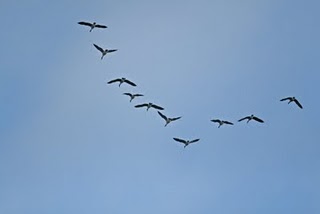
I saw my first “V” formation of Canada geese of this fall and it got me thinking about migratory triggers. Here in North America the days are starting to get notably shorter, sunset is now about an hour earlier than it was in June. Most animals have circadian rhythms that are tuned to environmental cues like day length. In many species, the shorter day length along with cooler temperatures is the sign of coming winter and triggers migratory behavior.
Inside the brain of mammals like ourselves lies a tiny organ called the suprachiasmatic nucleus (SCN for short). Despite being the size of a rice grain, the SCN plays a large role in the body’s biological clock. It exerts control over other regions of the brain through nerve signals and biochemical activity and research shows that individuals with damaged SCNs have difficulty with daily sleep/wake cycles. The SCN gets input from light receptors and thus able to adjust the body’s clock to match external light patterns. The adjustment of the internal clock is gradual though (why do think that is?) and it can take a few days to adapt to a rapid change in day length. We humans call this condition “jet lag”; do you think geese feel jet lag? Birds do have a SCN but the system doesn’t work exactly that of mammals and their brain anatomy is different.
I’ve posted two questions this month, you can write your answers in the comment section if you want some feedback from me.
Isn't that kinda like "supercalifragilisticexpialidocis?
Seriously, is it the gooney bird that flies for months, then can't remember how to land? I seem to remember funny videos of these birds falling all over themselves after they touch ground. Does this have anything to do with the supra nuke?
Wendy,You might be thinking of the blue-footed booby. They are a seabird like the goony (Albatross) and have a particularly comical landing that looks like a controlled crash. Evolutionarily, they have traded landing stability for traits that make them more efficient at sailing aloft for months. Think of a glider vs. and airplane.
Hi!Congratulations! Your readers have submitted and voted for your blog at The Daily Reviewer. We compiled an exclusive list of the Top 100 museums Blogs, and we are glad to let you know that your blog was included! You can see it at http://thedailyreviewer.com/top/museumsYou can claim your Top 100 Blogs Award hereP.S. This is a one-time notice to let you know your blog was included in one of our Top 100 Blog categories. You might get notices if you are listed in two or more categories.P.P.S. If for some reason you want your blog removed from our list, just send an email to angelina@thedailyreviewer.com with the subject line "REMOVE" and the link to your blog in the body of the message.Cheers!Angelina MizakiSelection Committee PresidentThe Daily Reviewerhttp://thedailyreviewer.com